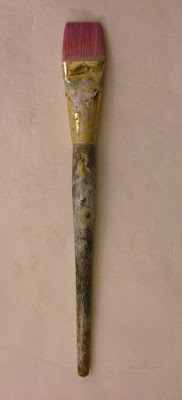This is my favourite brush. It may not be the best brush that I have, but I have had it for ten years, and no matter how often I've used it, or what I've drowned it in, it's always cleaned up and been usable. I bought it in London in 2000, so it's come with me across the Atlantic to the USA. It's been with me in three studios. I've used it for watercolours, acrylics, even oil paints. I've whisked it around in jars of pigment to mix up paints. I may even have used it for printmaking, so it's had all kinds of chemicals and inks on it. But every time that I used it, I washed it with warm water and a little detergent, then left it overnight in cold water, and every time the bristles sprang back into their original shape, like a cartoon animal that's flattened by an anvil and then - SPROING! - it's as good as new.
I have a set of beautiful Chinese brushes, but they are very delicate, they need a lot of care, and they can only be used for one thing. I have a few 12 inch round point brushes that can make broad, gestural marks with thick paint. I have small angled brushes, long-handled brushes with fine points, house-painter's brushes from 3 to 6 inches wide. Most of them lose their shape after a few months. Many of them end up being discarded (sorry, environment!). But this ten year old brush just keeps on going.
There's very little in my life that I have from ten years ago. Just a few books, several hundred CDs, and some canvases still in their packing material that came with me from London to Chicago in 2002.
And this brush. If I were a general, and this brush were a soldier I would have to promote it to a higher rank, or at the very least give it an important award.
Arise, Sir Brush! Truly you have given excellent service! May your bristles never wilt, but continue standing stiff and straight (if a little discoloured) for another decade.
